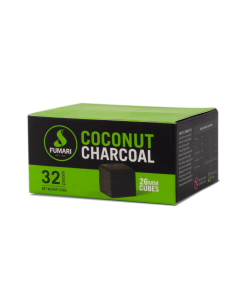Hookah is a special type of water pipe which is used to smoke flavored tobacco known as shisha, and it has become increasingly popular among social circles in recent years. However, any hookah will require the use of heat to create the perfect smoking experience, and that’s why anyone swinging by their local headshop needs to grab some hookah coal. To the uninicoconut charcoal briquettes surprise, but there are quite a few different types of hookah coal available, so we’ve compiled this comprehensive guide to help you confidently select the best coal option to fit your needs.
The Basics Of Hookah Coals
At its core, hookah coal primarily consists of two main ingredients: combustible material and a binding agent. The former may vary depending on what particular coal you’re looking at, but four of the most common materials used are charcoal, mesquite, coconut shells, and petroleum products. Whereas the binder holds everything together, enables a slow and even burn, and can influence the amount of odor and smoke produced.

Traditionally, specifically charcoal coals were used for hookah, however, now thanks to industrialization, you can find coals to fit all sorts of needs. Depending on what you’re looking for, there are both quick-lighting and natural charcoal options, with each type offering various advantages as well as disadvantages.
The Different Types Of Hookah Coals
Let’s start with the traditional option, natural charcoals. Made from burning wood, this method is widely regarded as the “original” form of making coal and involves no additional chemicals or additives. These natural coals tend to release an authentic smoke but because it’s made without any binding agents, they can often produce more odor and ash compared to other options.
Another type of coal used with certain hookahs is quick-light. This is manufactured using a combination of sawdust and other natural materials like coconut shells which are then compressed and chemically treated with an ignition compound. The added chemicals result in a coal that is ready to light up quickly, usually with a simple lighter. Unfortunately, this convenience comes at a price as these coals will smell different due to its chemical nature, and many users will be put off by it.
Coconut charcoal briquettes are relatively newer forms of coal that became famous for their longer lasting burn times and reduced smell. Unlike the previous two, coconut coal is not made from the burning of trees but instead from the shells of coconuts. The coconut shell is heated with little to no oxygen until it is charred, and then mixed with a small amount of starch, which helps keep the coal together during use.
Finally, let’s look at petroleum-based coals. Unlike the others, these coals are not 100% natural and are combined with other filler material and a binding agent to create a coal which lights faster, lasts longer and gives off less smoke than natural charcoals. Despite the increased convenience, these coals can contain potentially dangerous fumes so they should be used cautiously and only in well ventilated areas.
How To Use Different Hookah Coals
Now that you know the different varieties of hookah coal available, here’s a quick guide on how to properly use them. If you’re just starting out, we recommend going with natural charcoals as they are the easiest to handle.
With those, you typically need to use a companion such as a stovetop or electric burner. Place your coals directly onto whichever heating device you’ve chosen and allow them to heat up for around 10 minutes. Then, when they start turning grey and glowing, you can pick them up with tongs and place them onto your bowl, which should already have packed shisha.
As for quick-light coals, they are much easier to handle since you won’t need any additional devices. With them, all you’ll need to do is light one up with a regular lighter and it should be ready to go in around 20 seconds. After they are lit, simply place them onto your shisha bowls and enjoy your session. Lastly, with petroleum coals, we advise following the manufacturer’s instructions closely as the usage may vary depending on the brand.
Finding The Best Hookah Charcoal Option
By now, you should have a clearer understanding of the different types of hookah coal available and how to use them. However, if you’re still feeling unsure as to which one is right for you, the best way to decide is by experimenting and getting a feel for each kind to see which fits your preference best.
Ultimately, the decision on which hookah coal option to go with really depends on the user and their specific requirements, from how it tastes and smells to how long it lasts. Whichever coal you choose, make sure that it fulfills your expectations as it is integral to having a pleasurable smoking session with friends and family.







